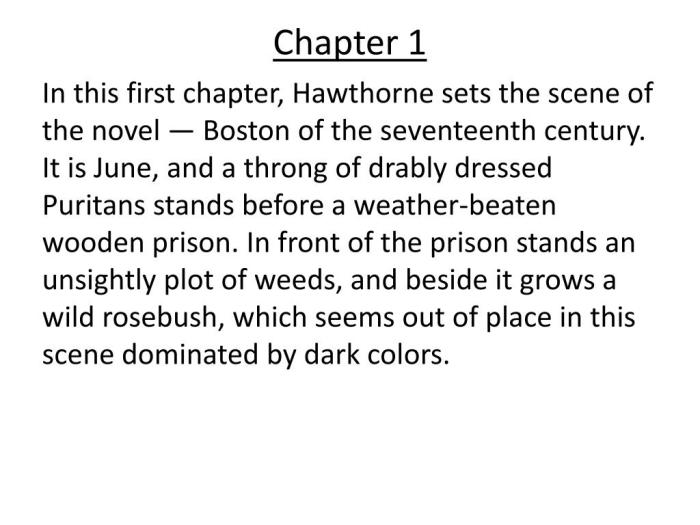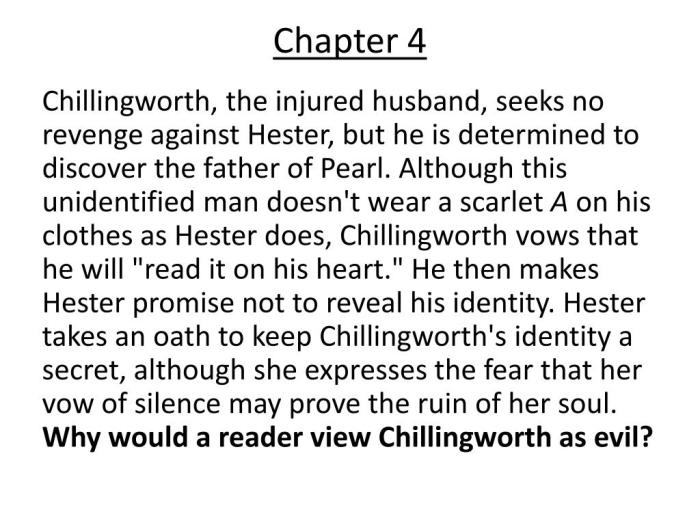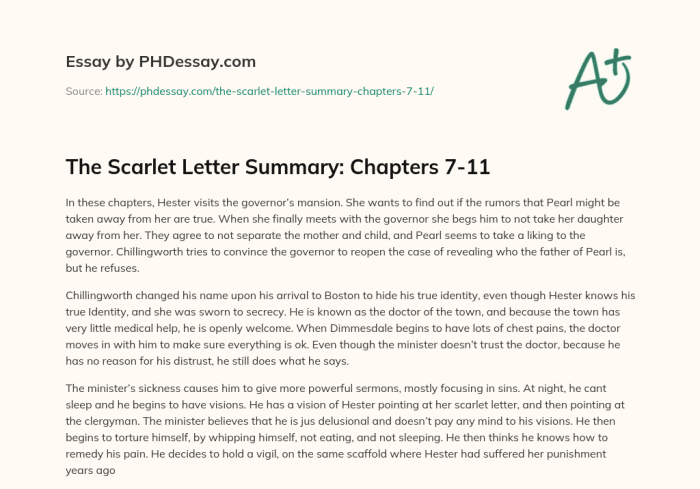Chapter 4 scarlet letter summary – Embark on a journey through Chapter 4 of Nathaniel Hawthorne’s “The Scarlet Letter,” where we delve into the profound themes and captivating symbolism that shape this literary masterpiece. Through a meticulous analysis of events, characters, and literary devices, this chapter summary unveils the intricate tapestry woven by Hawthorne.
Chapter 4 introduces us to the emotional turmoil of Hester Prynne and her interactions with the Puritan community. We witness the transformative power of her character as she navigates the complexities of her situation. Moreover, the chapter is rich in symbolism, with the scarlet letter serving as a potent reminder of Hester’s past and the societal judgment she faces.
Chapter 4 Overview
Chapter 4 of Nathaniel Hawthorne’s The Scarlet Letter, titled “The Interview,” depicts a pivotal encounter between Hester Prynne and Arthur Dimmesdale in the forest. This encounter reveals the complexities of their relationship, the weight of their shared secret, and the evolving dynamics of Puritan society.
Significance of Chapter 4
- It marks a turning point in the novel, shifting the focus from Hester’s public humiliation to the private struggles of the characters.
- It explores the themes of guilt, redemption, and the transformative power of love.
- It foreshadows the eventual revelation of Dimmesdale’s secret and the consequences that follow.
Character Analysis: Hester Prynne
In Chapter 4, Hester Prynne emerges as a multifaceted character, grappling with the burden of her sin and the complexities of her emotions.
Hester’s Emotional State
- She is torn between her love for Dimmesdale and her duty to protect him.
- She feels both shame and defiance, recognizing the hypocrisy of the Puritan community.
- She yearns for redemption but struggles to find a path forward.
Hester’s Transformation
- She begins to question the validity of the community’s judgment.
- She develops a sense of self-reliance and resilience.
- She becomes a symbol of both the consequences of sin and the possibility of redemption.
Symbolism and Motifs
Chapter 4 is rich in symbolism and motifs that contribute to the novel’s themes and foreshadowing.
Key Symbols
- The Forest:Represents a place of both temptation and potential redemption.
- The Scarlet Letter:Embodies Hester’s sin and its enduring consequences.
- The Black Man:Symbolizes the devil and the corrupting influence of sin.
Motifs
- Guilt and Redemption:The characters wrestle with the burden of their past actions and the possibility of forgiveness.
- Hypocrisy and Social Conformity:The Puritan community’s strict adherence to rules masks a hidden world of sin and deception.
- The Power of Love:Hester and Dimmesdale’s love for each other offers a glimmer of hope amidst the darkness.
Literary Devices and Techniques

Hawthorne employs various literary devices in Chapter 4 to enhance the reader’s understanding and appreciation of the story.
Foreshadowing
- The mention of the Black Man hints at the sinister forces at work in the novel.
- Hester’s request for Dimmesdale to leave with her foreshadows the eventual revelation of their secret.
Irony
- The Puritans’ emphasis on outward purity contrasts with the hidden sins of their society.
- Hester’s public humiliation becomes a catalyst for her inner transformation.
Imagery, Chapter 4 scarlet letter summary
- The vivid descriptions of the forest create a sense of mystery and foreboding.
- The contrast between light and shadow reflects the characters’ inner struggles.
Connections to Other Chapters

Chapter 4 builds upon and connects to other chapters in the novel, enriching the overall narrative.
Chapter 1: The Prison-Door
- It expands on Hester’s character development and the social consequences of her sin.
Chapter 2: The Market-Place
- It further explores the hypocrisy and social dynamics of Puritan society.
Chapter 3: The Recognition
- It deepens the relationship between Hester and Dimmesdale and foreshadows the challenges ahead.
Historical and Cultural Context
Chapter 4 reflects the historical and cultural context of 17th-century Puritan New England.
Puritan Society
- The chapter depicts the strict religious beliefs and social customs that governed Puritan life.
- It highlights the consequences of nonconformity and the emphasis on public punishment.
Witchcraft and the Devil
- The mention of the Black Man draws upon the widespread belief in witchcraft and the devil during this period.
Critical Reception

Chapter 4 has been widely praised for its literary merit and its exploration of complex themes.
Critical Perspectives
- Critics have lauded Hawthorne’s skillful use of symbolism and foreshadowing.
- The chapter has been seen as a pivotal moment in the novel’s exploration of sin, redemption, and the human condition.
Quick FAQs: Chapter 4 Scarlet Letter Summary
What is the significance of the scarlet letter in Chapter 4?
The scarlet letter “A” serves as a constant reminder of Hester Prynne’s past sin and the judgment she faces from the Puritan community.
How does Hester Prynne’s character develop in Chapter 4?
Hester’s character undergoes a transformative journey in Chapter 4, as she begins to question her past and seek redemption.
What is the symbolism of the forest in Chapter 4?
The forest represents a place of freedom and escape from the judgment of society.